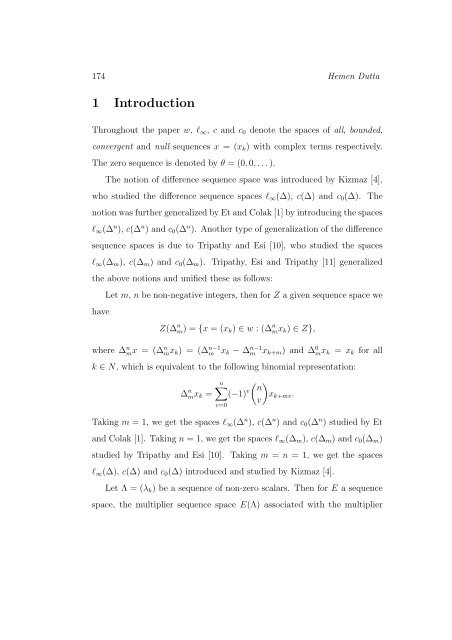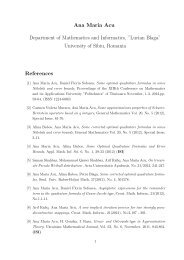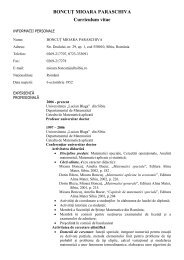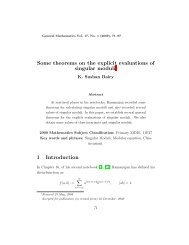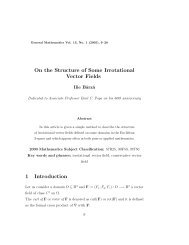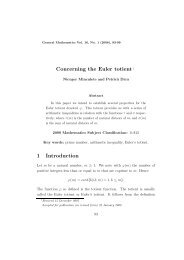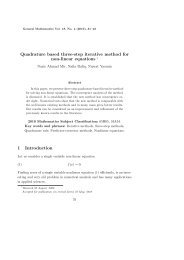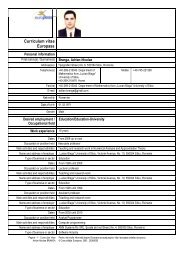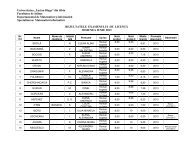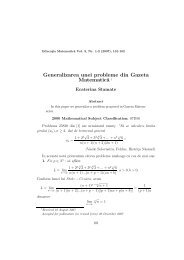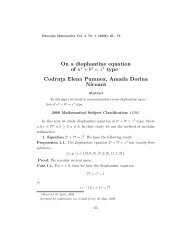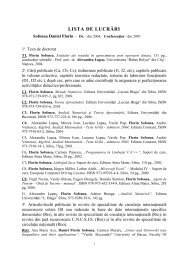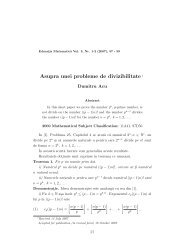Some multiplier difference sequence spaces defined by a sequence ...
Some multiplier difference sequence spaces defined by a sequence ...
Some multiplier difference sequence spaces defined by a sequence ...
Create successful ePaper yourself
Turn your PDF publications into a flip-book with our unique Google optimized e-Paper software.
174 Hemen Dutta1 IntroductionThroughout the paper w, l ∞ , c and c 0 denote the <strong>spaces</strong> of all, bounded,convergent and null <strong>sequence</strong>s x = (x k ) with complex terms respectively.The zero <strong>sequence</strong> is denoted <strong>by</strong> θ = (0, 0, . . . ).The notion of <strong>difference</strong> <strong>sequence</strong> space was introduced <strong>by</strong> Kizmaz [4],who studied the <strong>difference</strong> <strong>sequence</strong> <strong>spaces</strong> l ∞ (∆), c(∆) and c 0 (∆). Thenotion was further generalized <strong>by</strong> Et and Colak [1] <strong>by</strong> introducing the <strong>spaces</strong>l ∞ (∆ n ), c(∆ n ) and c 0 (∆ n ). Another type of generalization of the <strong>difference</strong><strong>sequence</strong> <strong>spaces</strong> is due to Tripathy and Esi [10], who studied the <strong>spaces</strong>l ∞ (∆ m ), c(∆ m ) and c 0 (∆ m ). Tripathy, Esi and Tripathy [11] generalizedthe above notions and unified these as follows:haveLet m, n be non-negative integers, then for Z a given <strong>sequence</strong> space weZ(∆ n m) = {x = (x k ) ∈ w : (∆ n mx k ) ∈ Z},where ∆ n mx = (∆ n mx k ) = (∆ n−1m x k − ∆ n−1m x k+m ) and ∆ 0 mx k = x k for allk ∈ N, which is equivalent to the following binomial representation:∆ n mx k =n∑( ) n(−1) v x k+mv .vv=0Taking m = 1, we get the <strong>spaces</strong> l ∞ (∆ n ), c(∆ n ) and c 0 (∆ n ) studied <strong>by</strong> Etand Colak [1]. Taking n = 1, we get the <strong>spaces</strong> l ∞ (∆ m ), c(∆ m ) and c 0 (∆ m )studied <strong>by</strong> Tripathy and Esi [10]. Taking m = n = 1, we get the <strong>spaces</strong>l ∞ (∆), c(∆) and c 0 (∆) introduced and studied <strong>by</strong> Kizmaz [4].Let Λ = (λ k ) be a <strong>sequence</strong> of non-zero scalars. Then for E a <strong>sequence</strong>space, the <strong>multiplier</strong> <strong>sequence</strong> space E(Λ) associated with the <strong>multiplier</strong>


